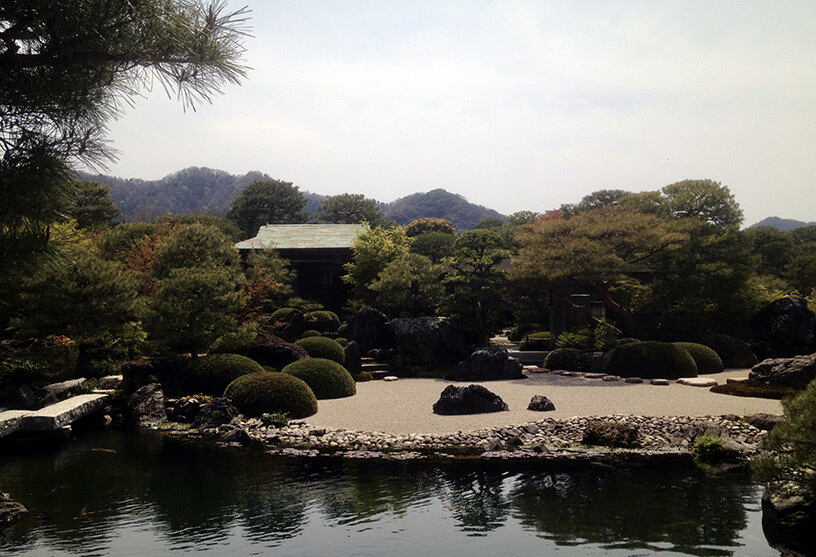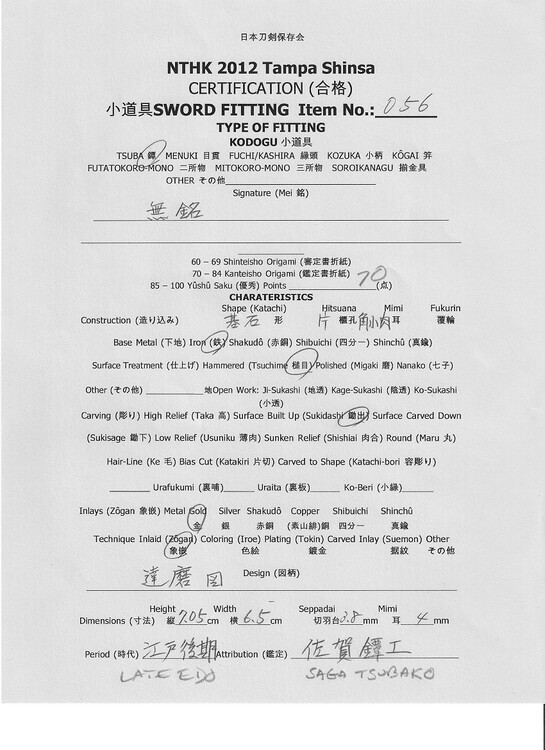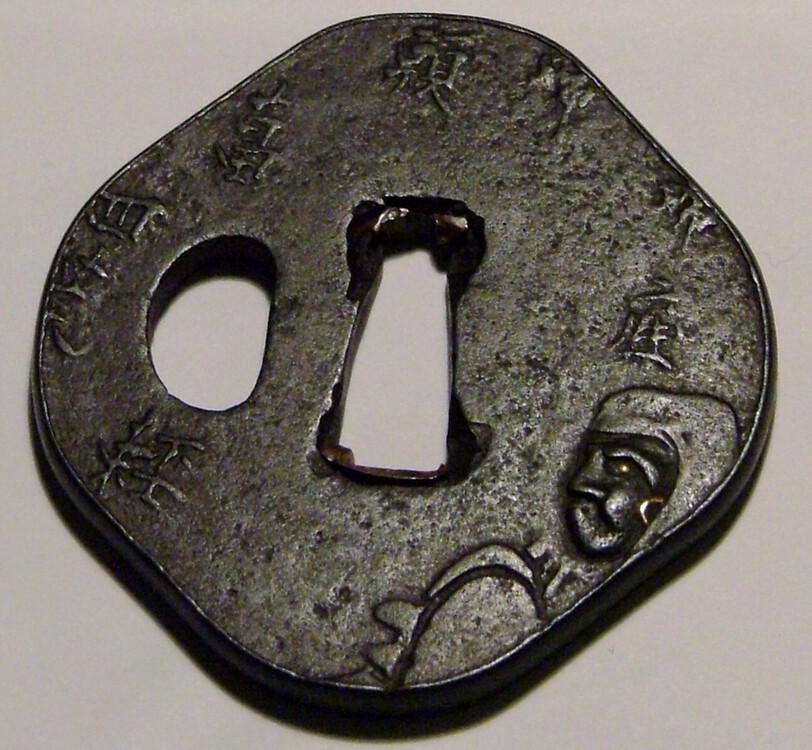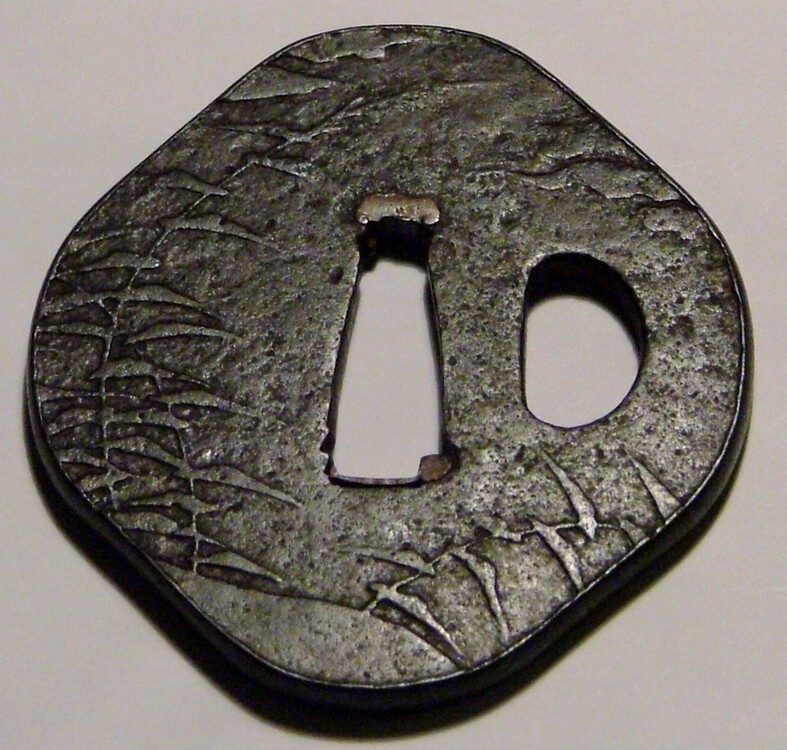-
Posts
2,899 -
Joined
-
Last visited
-
Days Won
3
Content Type
Profiles
Forums
Events
Store
Downloads
Gallery
Everything posted by Soshin
-
Hi Ford, I think the rough carving is intentional on the part of tsubako as well as a limitation of the medium. Sometimes tsubako would strive for simplicity, rusticity, and gauche in such a bold design. I was referring to the carving as katakiri-bori because the angle of the cuts by the chisel long the surface of the tsuba. I would agree in kinko tosogu the carving of katakiri-bori is often complex and looks like strokes of a painters brush. I think there are three factors effecting the cuts of the chisel in this context one is the softness of the medium in the case of kinko tosogu made of something like shakudo, shibuchi, or something hard like iron, the skill of the artisan, and intended effect of the design as controlled by tsubako. Hi Fred D., Thanks for the comment. I love how the rim and overall shape of the tsuba is included into the design on the tsuba. The brass dot inlays also do a good job contrasting with the darkness of the iron and highlighting the peddles of the Wisteria. Yours truly, David Stiles
-
Hi Ford, Thanks for the reply and the help. You are right to not put much emphasis of the inlays. Can't sleep so I was up looking at some of my many tosogu books. From looking at how the Wisteria design is rendered I think the technique is katakiribori (片切彫) which I don't see often in iron. This carving technique is more often seen in kinko tsuba and other tosogu. The carving looks to extend into the shape of the rim forming the individual petals of the Wisteria flower. The adjusting chisel marks (yose-tagane) around the nakago-ana as well as the shape of the kogai-hitsu ana reminds me of some of the Higo schools. I am not to knowledgeable when it comes to Higo schools in general and will need to do more research on that. :? Yours truly, David Stiles
-
Hi Everyone, I often don't list tsuba help topics on the NMB as I have became more experienced (10 years now) but this new tsuba of mine I don't have a clue in terms of the school. :? It has brass inlays that by virtue of their color indicates a early production period when brass was imported from China before the Edo Period. The style of inlay is different then what you see in Heianjo, Onin, or Kaga tsuba therefore the idea of Ko-Shoami comes to mind as they also often used brass inlays but in a different style. The measurements for the tsuba are as follows: 8.0 X 7.5 cm with a tickness of 4 mm at the mimi as well as the seppa-dai. Thank you for taking the time to read and reply to my post. The design in Japanese is Fuji meaning the Japanese Wisteria flower (Wisteria floribunda). The Wistera flower is often found in the kamon of samurai of the Kaga Province modern day Yamanashi Prefecture west of Tokyo near Mount Fuji. Yours truly, David Stiles
-
Hi Rob M., Could you please list the thickness of the tsuba at the rim also? Is the rim or center of the tsuba the thickest? Thank you. Yours truly, David Stiles
-
Hi, The first tsuba is a tempo tsuba and a nice one circa the late Edo Period. The main characterics are the large size, apparent hammer marks (tsuchimei-ji), and hot stamp designs. The second tsuba I am not sure about. Yours truly, David Stiles
-
Hi Rob M., I would try to remove some of the rust. Using bone or irony is fine. Please provide measurements and some shots of the rim. It will help ID the tsuba. Yours truly, David Stiles
-
Hi Everyone, Not sure about the first two but the third one is a Nara school tsuba like middle Edo Period. It is not Ko-Nara. Hope you find the information helpful. Yours truly, David Stiles
-
Hi Peter F., I was thinking Shoami circa middle Edo Period early 1700s. The iron is very similar to a one I have in my collection. I don't see any kebori on your tsuba like the one refernced. Kebori and very sharp ji-sukashi is often seen in Akasaka school work. Yours truly, David Stiles
-
Hi Fred D., I really like the Saotome tsuba. It is a really nice find at the show congratulations. I also purchased a early Saotome tsuba that I think is from the late Muromachi Period. I was thinking the design is a cross (mokko). It has both copper and shakudo sekigane. Here is a photograph of my Saotome tsuba. Enjoy. Curtis R., Sorry to hear about your car accident hopefully you will be able to make it to another show this year. Take care. Yours truly, David Stiles
-
You could be right it's hard to see if the rim is a fukurin or iron polished and turned up like my Daruma tsuba rim is. Pete's observation is a vaid one. Mid to late Edo period Shoami would make sense. With all the inserts being original to the tsuba. Nice tsuba I like it. Yours truly, David Stiles
-
Hi Alex, The rim is very similar to my tsuba it is a type of small turn back rim referred to as uchikaeshi-mimi (打返耳) in Japanese. The many ko-sukashi elements, that have been later filled with shakudo (赤銅), thickness of tsuba plate, and style rim reminds be of Edo Period Katchushi (甲冑師) (i.e. armor makers tsuba). Providing complete measurements including thickness would be helpful. Yours truly, David Stiles
-
Hi Henry, I would say that my tsuba Daruma image does look more like the woodblock print by Yoshitoshi circa 1887 freatured in the Wikipedia entry for Daruma. Especially when comparing them to the classic pieces made by Kaneie and Nobuie posted on this thread. Yours truly, David Stiles
-
Hi Henry Wilson, I would agree both the Nobuie and the Kaneie has some influence on the design of my tsuba even though the school was well known to copy Kaneie masterpieces. Does anyone know if the Nobuie tsuba with Daruma and Kanji was part of the orignal publication of the Nobuie tsuba Oshigata made by Nakamura circa 1850? If so then my tsuba was likely made around 1850. The Kanji in the air above Daruma head is likely a Zen Buddhist Koan (公案) as Daruma is a common subject of many Koan used as a Zen meditation aid. A really well know one featuring Daruma is as follows: Hi Eric, Here a black and white copy of the NTHK worksheet. Some of the information I have taken and included it in the write up. Thanks for the interest. Yours truly, David Stiles
-
Hi Richard George, The original attribution made by Skip H. was Hoan, early Edo Period. I asked Jim G. about this after the shinsa and he said the iron is too homogenous to be the work of the Hoan school even the later work. The design is also made classic by Meijin Shodai Kaneie. When I get a chance I will look for a photo of the oringial Kaneie masterpiece. Yours truly, David Stiles
-
Hi Eric, Thanks for the kind words. The origami will be issued in about four to six months from the date of the shinsa. I can post a scan of the worksheet if there are no objections. If no one has any objections I will post it when I get home from work. Yours truly, David Stiles
-
Here is the write up I have of the Daruma tsuba after the results of the NTHK shinsa: I came across something interesting in reading Tsuba An Aesthetic Study by Robert Haynes and Kazutaro Torigoye: I think my tsuba represents some of the later (i.e. late Edo Period) unsigned work showing the best craftsmanship of the school. Thanks for taking the time to read though my results. I asked the shinsa team to translated the Kanji but they weren't able to as it consisted of ancient Chinese characters. Mr. Yoshikawa said that his father could have been able to translate the characters but that his knowledge was not as great as his father's in regards to such old characters. Yours truly, David Stiles
-

Tampa Show
Soshin replied to sensei215's topic in Sword Shows, Events, Community News and Legislation Issues
Hi Everyone, Just wanted to update everyone the final show total for me was four new tsuba, three wood boxes, and two books. I purchased two tsuba that are by far the oldest I have ever had in my collection from a long time collector. I will post once I have more free time. Yours truly, David Stiles -
Hi Everyone, My paper was in the mail this evening. I really like. Thanks Chris Bowen and Larry Klahn. I will have some fun translating it. Yours truly, David Stiles
-
Hi Everyone, I was able to see this tsuba in person at the Tampa show. It is a wonderful site to see. A bit out side of my price range. :lol: Here is a papered tsuba I have with the same Chinese coin design for reference. More information about it is at my website. Yours truly, David Stiles
-
Hi Robert S., I am looking forward to getting my paper for the tsuba I submitted as well. Did they come in the mail? I might want to follow up with Chris Bowen about this but have been very busy after the Tampa show. I did well at the Tampa shinsa as well. Will post about that later. Yours truly, David Stiles
-

Tampa Show
Soshin replied to sensei215's topic in Sword Shows, Events, Community News and Legislation Issues
Hi Everyone, Wasn't going to buy anything at the show this year. The two tsuba, three wood boxes, and two books don't count... Yours truly, David Stiles -
Hi John B., How hard is the iron? Saotome have extremely hard iron even compared to Tempo school work. Once in awhile you come across good tsuba like this on eBay selling at a great price. Yours truly, David Stiles
-

Tampa Show
Soshin replied to sensei215's topic in Sword Shows, Events, Community News and Legislation Issues
Hi Everyone, I will be there tomorrow morning around 11:00 AM. I have a early flight tomorrow. I will stay until the end of the show. I have a shinsa slot for Sunday morning. Will bring a few tsuba. Yours truly, David Stiles -
Hi Steve, This was just a thought experiment on my part and nothing more to explain the shinsa result. It was not a codified theory. Yours truly, David Stiles








